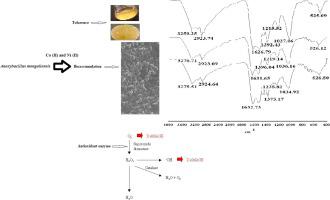当前位置:
X-MOL 学术
›
Comp. Biochem. Physiol. C Toxicol. Pharmacol.
›
论文详情
Our official English website, www.x-mol.net, welcomes your
feedback! (Note: you will need to create a separate account there.)
Resistance, removal, and bioaccumulation of Ni (II) and Co (II) and their impacts on antioxidant enzymes of Anoxybacillus mongoliensis.
Comparative Biochemistry and Physiology C: Toxicology & Pharmacology ( IF 3.9 ) Pub Date : 2020-05-13 , DOI: 10.1016/j.cbpc.2020.108790 Mahire Bayramoglu Akkoyun 1 , Sadin Ozdemir 2 , Ersin Kilinc 3 , Emre Birhanli 4 , Ayşenur Aygün 5 , Fatih Sen 5
Comparative Biochemistry and Physiology C: Toxicology & Pharmacology ( IF 3.9 ) Pub Date : 2020-05-13 , DOI: 10.1016/j.cbpc.2020.108790 Mahire Bayramoglu Akkoyun 1 , Sadin Ozdemir 2 , Ersin Kilinc 3 , Emre Birhanli 4 , Ayşenur Aygün 5 , Fatih Sen 5
Affiliation

|
In this study, it was hypothesis that A. mongoliensis could be used as bioindicator for Ni (II) and Co (II). Thus, Ni (II) and Co (II) resistance, removal, bioaccumulation, and the impacts of them on antioxidant enzyme systems of thermophilic Anoxybacillus mongoliensis were investigated in details. The bioaccumulation of Ni (II) and Co (II) on the cell membrane of thermophilic A. mongoliensis, variations on surface macrostructure and functionality by FT-IR and SEM, and determination of antioxidant enzyme activities were also tested. The highest bioaccumulation values of Co (II) and Ni (II) were detected as 102.0 mg metal/g of dry bacteria at 10 mg/L for the 12th h and 90.4 mg metal/g of dry bacteria for the 24th h, respectively, and the highest Ni (II) and Co (II) cell membrane bioaccumulation capacities of A. mongoliensis were determined as 268.5 and 274.9 mg metal/g wet membrane, respectively at the 24th h. In addition, increasing on SOD and CAT activities were observed on depend of concentration of Ni (II) and Co (II) with respect to control. The antioxidant enzyme activity results also indicated that A. mongoliensis might be used as a bioindicator for Ni (II) and Co (II) pollution in environmental water specimens.
中文翻译:

Ni(II)和Co(II)的抗性,去除和生物积累及其对蒙古无氧杆菌的抗氧化酶的影响。
在这项研究中,有一个假设是蒙古沙门氏菌可以用作Ni(II)和Co(II)的生物指示剂。因此,详细研究了镍(II)和钴(II)的抗性,去除,生物富集以及它们对蒙古嗜热嗜热芽孢杆菌的抗氧化酶系统的影响。还测试了嗜热气单胞菌细胞膜上镍(II)和钴(II)的生物富集,FT-IR和SEM的表面宏观结构和功能的变化以及抗氧化酶活性的测定。在第12 h时,Co(II)和Ni(II)的最高生物累积值分别为102.0 mg金属/ g干细菌和10 mg / L,第24 h中90.4 mg金属/ g干细菌。蒙古曲霉的Ni(II)和Co(II)细胞膜生物累积能力最高,为268。在第24 h分别为5和274.9 mg金属/ g湿膜。另外,观察到SOD和CAT活性的增加取决于相对于对照的Ni(II)和Co(II)的浓度。抗氧化酶活性的结果还表明,蒙古曲霉可以用作环境水标本中Ni(II)和Co(II)污染的生物指标。
更新日期:2020-05-13
中文翻译:

Ni(II)和Co(II)的抗性,去除和生物积累及其对蒙古无氧杆菌的抗氧化酶的影响。
在这项研究中,有一个假设是蒙古沙门氏菌可以用作Ni(II)和Co(II)的生物指示剂。因此,详细研究了镍(II)和钴(II)的抗性,去除,生物富集以及它们对蒙古嗜热嗜热芽孢杆菌的抗氧化酶系统的影响。还测试了嗜热气单胞菌细胞膜上镍(II)和钴(II)的生物富集,FT-IR和SEM的表面宏观结构和功能的变化以及抗氧化酶活性的测定。在第12 h时,Co(II)和Ni(II)的最高生物累积值分别为102.0 mg金属/ g干细菌和10 mg / L,第24 h中90.4 mg金属/ g干细菌。蒙古曲霉的Ni(II)和Co(II)细胞膜生物累积能力最高,为268。在第24 h分别为5和274.9 mg金属/ g湿膜。另外,观察到SOD和CAT活性的增加取决于相对于对照的Ni(II)和Co(II)的浓度。抗氧化酶活性的结果还表明,蒙古曲霉可以用作环境水标本中Ni(II)和Co(II)污染的生物指标。











































 京公网安备 11010802027423号
京公网安备 11010802027423号